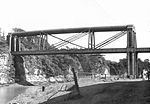Portal:Trains/Selected article/Week 18, 2006
The Chepstow Bridge, sometimes called the "Great Tubular Bridge", was a railway bridge built in 1852 by Isambard Kingdom Brunel to cross the River Wye (which forms part of the border between England and Wales) at Chepstow. It was a unique and elegant engineering achievement, and economic in its use of materials. It would also prove to be the design prototype for the great bridge at Saltash. For the Chepstow Bridge, Brunel had to take the two tracks of the South Wales Railway across the river Wye. The Admiralty had insisted on a 300-foot (91 m) clear span over the river, with the bridge a minimum of 50 feet (15¼ m) above high tide. The span would have to be self supporting, since although the Gloucestershire side of the river consists of a limestone cliff, the Monmouthshire side is low-lying sedimentary deposit subject to regular flooding. Thus on that side, there was nowhere for an abutment capable of either resisting the outward push of an arch bridge, or the inward pull of a conventional suspension bridge. In any case, neither could be used; an arch bridge would not have met the height and width restrictions imposed by the Admiralty, and suspension bridges were notoriously unfit for carrying railway trains. The concentrated weight caused the chains to deflect, allowing the bridge-deck to ride dangerously up and down. A self-supporting truss bridge was the only option.
Recently selected: Building the Virginian Railway - Maglev train - Danske Statsbaner

